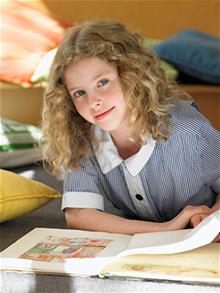 Poetry has been described by Laurence Perrine, the author of Sound and Sense: An Introduction to Poetry, as a language that “says more and says it more intensely than ordinary language.” When engaging with poetry, meaning should be the most important aspect, followed by elements and devices. Poems selected for children should let them think and “be” more to create a knowledgeable experience for them, with the expression of intense feelings and ideas, and with particular attention paid to diction, imagery, sound, metaphor, theme, rhythm, and rhyme. But, in all of their complexity, poems can also introduce students to basic realities of life through attractive language and imagery. When children become interested in poems, strong messages and morals can be explained and discussed to nurture young minds.
Poetry has been described by Laurence Perrine, the author of Sound and Sense: An Introduction to Poetry, as a language that “says more and says it more intensely than ordinary language.” When engaging with poetry, meaning should be the most important aspect, followed by elements and devices. Poems selected for children should let them think and “be” more to create a knowledgeable experience for them, with the expression of intense feelings and ideas, and with particular attention paid to diction, imagery, sound, metaphor, theme, rhythm, and rhyme. But, in all of their complexity, poems can also introduce students to basic realities of life through attractive language and imagery. When children become interested in poems, strong messages and morals can be explained and discussed to nurture young minds.
Three things are evoked when a poem is brought to a reader’s mind: images, emotions, and concepts. Though educators often focus on images and emotions conceptualized by poetry, they frequently miss opportunities to introduce young students to realities of life. Sadly, many children will not get this exposure elsewhere, so their curiosity must be nurtured by educators who may be the only people who will truly prepare them for their future life. Although children have no fear of exploring, teachers must equip them to do so safely.
Children must be able to enjoy the poem for what it is on the surface and also understand the strong messages hidden in the language. They must be given equal opportunities to understand the “inside-out idea” in the content of the poem and gain meaning with more detailed study of the text itself. Because poetry uses such colorful language, a reader usually becomes and remains excited and open to learn grand ideas that may be helpful to his or her life.
I remember making a group of third graders aware of their surroundings by using Jeannie Kirby’s poem “I Wonder.” This poem explores the many questions of a curious child and was used to answer my students’ many questions about nature. Instead of looking at repetition and rhymes among other poetic elements, I first engaged students in understanding the content of the poem, which led to discussions that, in turn, led my students to better understand the world around them.
I also engaged my students in the poem “Alligator” by Grace Nichols. This was a tremendous session. Students explored the poem, which spoke of the “slushy” river where alligators were found and what children should do if they ever see one. By the end of the discussion, and of the lesson overall, students were able to say how careful they would be when going home from school (not stopping by rivers and damps); students also created warning posters as a class activity and pretended to place it at the slushy river to warn persons of the dangers of the alligators. This poem allowed students to understand safety, and I know they will apply this knowledge to alligators as well as other creatures. I am sure that because of the lessons learned through poetry, students will be better able to understand and know how to act in situations because of the experiences they have read about. The vivid language used in poetry is a great tool for bringing realities to life.
When teaching curious children the realities of life through poetry, it must be established that not everything they see or hear is true. Children must know it is good to question content and that they should not hastily act on anything, including what they read. Curious children especially at the pre-operational and operational stages must be steered in truth, as they are still unaware of many realities of life. Because of the captivating language and rich dynamics, poetry is a great vehicle that moves children from fantasy to reality; poetry is, therefore, a dynamic tool for teaching curious children. As the French poet Anatole France said, “The whole art of teaching is only the art of awakening the natural curiosity of young minds for the purpose of satisfying it afterwards.”
 Marique Daugherty is a language and literacy specialist from Jamaica and was recently honored as one of ILA’s inaugural “30 Under 30.” She is currently teaching in London.
Marique Daugherty is a language and literacy specialist from Jamaica and was recently honored as one of ILA’s inaugural “30 Under 30.” She is currently teaching in London.